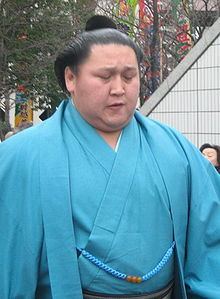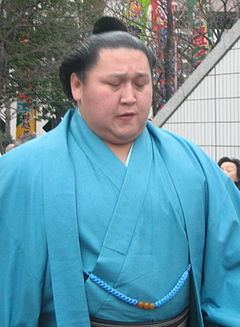Record 927-944-22 Highest rank Sekiwake (July, 2003) Championships Makuuchi (1) Role Sumo wrestler Height 1.91 m | Debut March, 1992 Retired July, 2015 Name Kyokutenho Masaru Makuuchi rank Maegashira (since 2009) Parents Asahikuni Masuo | |
 | ||
Weight 154 kg (340 lb; 24.3 st) Stables Tomozuna stable (since 2012), Oshima stable (1992–2012) Siblings Kyokushoten Kunihiro, Fudoyama Subaru, Kyokuhoten Tomoo Similar People Wakanosato Shinobu, Aminishiki Ryuji, Hakuho Sho, Tochiozan Yuichiro, Kisenosato Yutaka | ||
mongolian sumo wrestlers in japan www.ARAATAN.com
Kyokutenhō Masaru (旭天鵬 勝, born September 13, 1974 as Nyamjavyn Tsevegnyam, Mongolian: Нямжавын Цэвэгням) in Nalaikh, Ulan Bator, Mongolia is a former professional sumo wrestler. He made his debut in March 1992 out of Ōshima stable, with the first group of Mongolians ever to join the sport in Japan, reaching the top makuuchi division in January 1998. In his exceptionally long career he received seven special prizes for Fighting Spirit, and won one yūshō (or tournament), in May 2012 from the maegashira ranks, which made him at 37 the oldest first–time yūshō winner in sumo history, and he was runner-up in one other tournament. His highest rank was sekiwake, which he held on three occasions. He was the first wrestler since the 1950s to be ranked in the top division after the age of 40. He made more appearances in the top division than any other wrestler at 1470, and only Ōshio fought more than his 1870 career bouts. He announced his retirement in July 2015 and declared his intention to stay in sumo as an elder, having acquired Japanese citizenship in 2005. He is now known as Ōshima-oyakata.
Contents
- mongolian sumo wrestlers in japan wwwARAATANcom
- Career
- Retirement from sumo
- Fighting style
- Family
- References
Career

In 1991, Tsevegnyam came to Japan with five other Mongolian wrestlers, including Kyokushūzan, joining Ōshima stable. They were the first Mongolians to join professional sumo. In Mongolia he had had little experience of wrestling or judo, concentrating on basketball in junior high school. Six months after they came to Japan, due to cultural difference, language problems, and the extremely harsh training methods used in sumo, Kyokutenhō, Kyokushuzan and three others ran away and sought refuge in the Mongolian embassy, but he was persuaded by Kyokutenzan to return to his stable.
In March 1996, he was promoted to the second highest jūryō division, achieving sekitori status for the first time. After temporarily dropping down to makushita, he slowly climbed the jūryō division and first won promotion to the top makuuchi division in January 1998. However, he did not establish himself in the division until May 1999. He won his first sanshō or special prize in January 2000. He first achieved a san'yaku rank in January 2002 when he was promoted to komusubi. He has earned two kinboshi or gold stars for yokozuna upsets at maegashira rank, defeating Takanohana in the latter's comeback tournament in September 2002 and fellow Mongolian Asashōryū in his first tournament as a yokozuna in March 2003. He also defeated Asashōryū and Musashimaru whilst ranked in san'yaku. He made his sekiwake debut in July 2003 but didn't achieve a kachi-koshi or winning score in his three attempts at the rank.
On 28 April 2007 he caused a car accident in Tokyo. He was punished for defying the Japan Sumo Association's ban on wrestlers driving cars by being forced to sit out the May tournament, resulting in demotion to the jūryō division. This broke a string of over 700 consecutive top division bouts dating from his re-entry into makuuchi in May 1999, the longest streak among active wrestlers. However, he won immediate promotion back to the top division with a 12-3 record in July. On his return to the top division in September he was runner-up to yokozuna Hakuhō, his first ever runner-up score in makuuchi. He was awarded his fifth Fighting Spirit prize. In March 2009 he was promoted to komusubi for the first time in 17 tournaments, and became the first former san'yaku wrestler since Mitoizumi in 1988 to drop to the jūryō division and make a return to the san'yaku ranks. He made komusubi once again in July 2009.
Following the retirement of Kaiō in July 2011 Kyokutenhō became the longest serving member of the top division. It had been thought he would become head of Ōshima stable when Asahikuni reached the mandatory retirement age of sixty-five in April 2012, but Kyokutenhō was still comfortably ranked in the top division at the time, and active wrestlers are not permitted to become stablemasters. Instead he continued wrestling and transferred along with his colleagues to Tomozuna stable.
In May 2012, in his first tournament for his new stable, he won his first Emperor's Cup by beating Tochiōzan in a playoff after both finished with 12-3 records. In this tournament, Kyokutenhō had been in professional sumo just over twenty years, and at 37 years and 8 months was the oldest wrestler ever to take a top division championship in modern sumo history. He was also the first maegashira ranked wrestler to win a tournament since Kotomitsuki in 2001. Also, as Kyokutenhō had acquired Japanese citizenship, he was technically the first Japanese to win the championship since Tochiazuma in January 2006, although he will still be regarded as a 'foreign' champion in the Sumo Association's record book. His yūshō was the 50th won by a Mongolian born wrestler.
Despite his tournament victory Kyokutenhō did not return to the san'yaku ranks for the July tournament, instead being ranked at maegashira 1. He is the first maegashira to win the yūshō and not achieve san'yaku promotion since Sadanoyama in 1961. Kyokutenhō scored only 2–13 in this tournament, losing his first 13 bouts – the worst performance by a defending yūshō champion since Takatōriki also scored 2–13 in May 2000. In September 2014 he became the first 40-year-old to be ranked in makuuchi since the six tournament a year system began in 1958, and he also drew level with Terao on 1795 career appearances, behind only Ōshio's 1891. In November he won ten bouts and was awarded his seventh and final special prize, all for Fighting Spirit. In the May 2015 tournament he surpassed Kaiō's record with his 1445th appearance in the top division.
Retirement from sumo
Kyokutenhō left the ring in tears after losing his twelfth bout of the July 2015 tournament, a result which meant his demotion to the second division was certain. He announced his retirement the following day, stating "I have run out of strength and don’t have the spirit anymore." Hakuhō gave him a ride in the yokozuna's victory parade after winning the tournament. He became Ōshima-oyakata, and has a coaching role at Tomozuna stable. His danpatsu-shiki, or official retirement ceremony, was held in the Ryōgoku Kokugikan on 29 May 2016.
Fighting style
Kyokutenhō was a solidly yotsu-sumo wrestler, favouring techniques which involve grabbing the opponent's mawashi or belt. He preferred a migi-yotsu (left hand outside, right hand inside) grip. Over half his career wins were by a simple yori-kiri or force out, compared with an average of around 28 percent for all wrestlers.
Family
In 2005, Kyuokutenhō obtained Japanese citizenship with the support of his stablemaster, ex ōzeki Asahikuni. His legal name is now Masaru Ōta (太田 勝 Ōta Masaru). He is married to a Japanese woman and his first child, a girl, was born in September 2008.
Kyokutenhō's brother Luvsandorj (Лувсандорж), nine years his junior, also became a sumo wrestler in 2000 under the name Fudoyama, but he never climbed higher than the third makushita division and retired in January 2008.
He is the brother-in-law of the former maegashira Shōtenrō.
